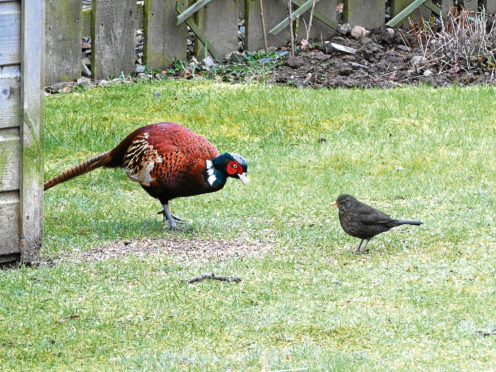The lengthening days raise my spirits. I can put up with the dreich mornings knowing that spring is just biding her time to make an entrance. The snowdrops in the woods are in full bloom and the pencil heads of daffodils are showing above ground and will add new colour when the snowdrops die away.
It has seemed a much more traditional winter than in recent years. Snow has fallen and lain. It’s melting now, a slow melt, which lets the water run off into the ground and drain gradually into the water courses.
Great spotted woodpeckers are drumming in the trees where Inka and I often walk first thing. The sound travels a surprising distance and it is mostly the male bird marking a territory and making his gorgeous presence known to single females looking for a mate. Occasionally one comes to the peanut feeder in the garden and we would welcome their visits more often.
A first in the five years we’ve lived in our present home has been a visit from a single greenfinch to the seed feeder. Sadly, it hasn’t returned and I wonder where it came from and where it is now. They are sociable birds and tend to move around in flocks and I hoped it might have brought some more into the garden.
Mistle thrushes are early nesters. They are not as common as song thrushes but I expect to hear their ringing song from the topmost branches of an old Wellingtonia in the home policies of the Big Hoose by the end of January at the latest. Despite my concern that they might have deserted our corner of the woods, in the past week I’ve heard one singing in a tall, old beech tree and the Doyenne and I saw another as we returned from walking Inka.
The shooting season finished on the first of this month. It would be fanciful to think that pheasants understand that life suddenly becomes safer but it is certainly the case that cock pheasants, especially, begin to experience a rise in testosterone and to show less fear of humans.
Not having seen one all winter, a cock pheasant has been dropping into the garden to hoover up the discarded seeds beneath the feeders. It’s not so unusual as it might seem – they are lazy birds which will quickly adapt to humans if they are fed.
Years ago I wrote about one that I watched fly from Brechin Castle across the River North Esk to the Brechin Cathedral graveyard, and from there fly into a neighbouring garden. It was Christmas and it was obviously being regularly fed – and it was safe from shooters.
It’s been a busy week with all sorts of unrelated events that this column thrives on. Driving from Edzell to Fettercairn, I saw a jackdaw standing on the head of a sheep; not so terribly unusual, as jackdaws sometimes pluck wool from sheep to line their nests. It seemed early to be thinking about nesting when they won’t be laying for another couple of months – but how would I know, it’s not my nest!
Recent mornings have been sunny and bright and the heat has soon driven off the frost. Packs of geese, heading up the coast, have flown high over the village. Etched against the cloudless sky, the easting sun picked up the light plumage of their breasts and pale forewings as they gossiped companionably among themselves.
This was quite a change from Monday night, out last thing with Inka. A thick mist covered the village and what seemed to be two packs of geese, disorientated but attracted to the village lights, were circling round calling to each other with a sense almost of panic. It was the start of the new moon and geese most often fly at night around the time of full moon when, there is best light. Perhaps these birds had flown into the mist moving between feeding grounds.
We took a turn round by Fasque Lake to see what activity there was there. A pair of mute swans with four young still with the dusty-brown remnants of their juvenile plumage, and dark bills which will soon change to the adult orange, were feeding and enjoying the sun.
I didn’t notice the two dark bodies swimming along the bank of the lake. It was a pair of mink, probably hunting for water voles. The moment they saw me, they dived and were gone before I even had time to lift my camera. It’s the second time I’ve seen mink there and the second time I’ve failed to get a picture.
The slender, angled wings and rusty-brown plumage glowing in the sunshine gave it away almost immediately. The long notched tail confirmed it was a red kite flying along the edge of the wood. Kites are becoming more common round our way and it would be very exciting if a pair decided to nest in the wood almost on our doorstep.
A busy week indeed – I’ve scarcely had a moment to myself.


